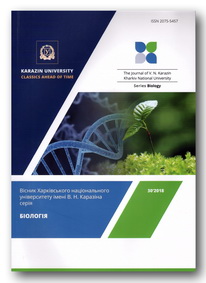Effects of body pigmentation mutations on Drosophila melanogaster mating behavior
Abstract
The model of congenic strains of Drosophila melanogaster was used to investigate the peculiarities of the effect of mutations in yellow (y), ebony (e), and black (b) genes involved in biogenesis of cuticle pigments on imago mating behavior indicators. The aim of this study was to find out if the effect of the given mutations on Drosophila imago mating behavior depends on the general genetic background on which they are realized. To achieve this goal, pairs of congenic strains were constructed using successive saturation crosses followed by selection for the marker phenotype resulted in each of the mutant alleles introduced in homozygous condition into the genotype of either Canton-S or Oregon-R wild-type stock instead of the corresponding wild-type allele present in these stocks initially. Individuals of strains resulted were tested for mating receptivity of females and mating activity of males. Each of the indicators was evaluated as a proportion of sexually mature but virgin individuals of a particular sex copulated successfully within the first hour after placing them in a test chamber with an excess of individuals of the opposite sex. According to the data obtained and the results of their statistical analysis, it was proved that the introduction of a mutation into the genetic background of the wild-type stock is accompanied with a change in the studied characteristics of imago mating behavior. The effect depends on the mutation introduced and on the genotype of the recipient stock. Thus, males of the yC-S strain are characterized by increased mating activity comparatively to males of the wild-type Canton-S stock. These results expand the known effects of yellow mutation. Males of the bC-S and eC-S strains, on the contrary, are less active than the males of the wild-type Canton-S stock. The most pronounced effects on mating receptivity of females were fixed for b (an increase in the indicator when introduced into Oregon genetic background) and e (a decrease when introduced into Canton-S genetic background) mutations. The indicators studied under the conditions of the given experimental scheme change in direct proportion (rS = 0,76; p < 0,05). In other words, if the strain is characterized by high mating activity of males, as a rule, a high mating receptivity of females will be also observed.
Downloads
References
Atramentova L.A., Utevskaya O.M. (2006). Statistical methods in biology. Kharkiv: Colorit. 224 p. (in Russian)
Borycz J., Borycz J.A., Loubani M., Meinertzhagen I.A. (2002). tan and ebony genes regulate a novel pathway for transmitter metabolism at fly photoreceptor terminals. The Journal of Neuroscience, 22, 10549–10557. https://doi.org/10.1523/JNEUROSCI.22-24-10549.2002
De Muth J.E. (2006). Basic statistics and pharmaceutical statistical applications. 2nd ed. Chapman & Hall/CRC, Boca Raton, FL. 714 p.
Dobzhansky Th., Holz A.M. (1943). A re-examination of the problem of manifold effects of genes in Drosophila melanogaster. Genetics, 28(4), 295–303. https://doi.org/10.1093/genetics/28.4.295
Heisenberg M. (1971). Separation of receptor and Lamina potentials in the electroretinogram of normal and mutant Drosophila. The Journal of Experimental Biology, 55, 85–100.
Hinkle D.E., Wiersma W., Jurs S.G. (2003). Applied statistics for the behavioral sciences. 5th ed. Boston: Houghton Mifflin. 756 p.
Hotta Y., Benzer. S. (1969). Abnormal electroretinograms in visual mutants of Drosophila. Nature, 222, 354–356. https://doi.org/10.1038/222354a0
Massey J.H., Akiyama N., Bien T. et al. (2019a). Pleiotropic effects of ebony and tan on pigmentation and cuticular hydrocarbon composition in Drosophila melanogaster. Front. Physiol., 10, 518. https://doi.org/10.3389/fphys.2019.00518
Massey J.H., Chung D., Siwanowicz I. et al. (2019b). The yellow gene influences Drosophila male mating success through sex comb melanization. eLife, 8, e49388. https://doi.org/10.7554/eLife.49388
Nikoro Z.S., Vasilyeva L.A. (1978). Problems of variation and selection on quantitative characters in Drosophila populations. Drosophila in experimental genetics. Novosibirsk: Nauka. P. 196–243. (in Russian)
Order of the Cabinet of Ministers of Ukraine № 650-р. (2013). On the classification of scientific objects as those that constitute National Heritage of Ukraine. https://zakon.rada.gov.ua/laws/show/650-2013-%D1%80#Text. (in Ukrainian)
Plokhinsky N.A. (1970). Biometrics. Moscow: Moscow State University. 365 p. (in Russian)
Pole I.R. (1979). Analysis of genetic determination of sexual activity in male Drosophila melanogaster. Abstract of Cand. Sci. (Biol.) Dissertation. Leningrad: Leningrad State University. 20 p. (in Russian)
Raposo G., Marks M.S. (2007). Melanosomes – dark organelles enlighten endosomal membrane transport. Nature reviews. Molecular cell biology, 8(10), 786–797. https://doi.org/10.1038/nrm2258
Richardt A., Rybak J., Störtkuhl K.F. et al. (2002). Ebony protein in the Drosophila nervous system: optic neuropile expression in glial cells. Journal of Comparative Neurology, 452, 93–102. https://doi.org/10.1002/cne.10360
Singh B.N., Singh A. (2016). The genetics of sexual behavior in Drosophila. Advances in Genomics and Genetics, 6, 1–9. https://doi.org/10.2147/AGG.S58525
Subocheva E.A., Romanova N.I., Karpova N.N. et al. (2003). Male reproduction behavior in Drosophila melanogaster strains with different alleles of the flamenco gene. Russ. J. Genet., 39(5), 553–558.
Suh J., Jackson F.R. (2007). Drosophila ebony activity is required in Glia for the circadian regulation of locomotor activity. Neuron, 55, 435–447. https://doi.org/10.1016/j.neuron.2007.06.038
True J.R., Yeh S.D., Hovemann B.T. et al. (2005). Drosophila tan encodes a novel hydrolase required in pigmentation and vision. PLOS Genetics, 1, e63. https://doi.org/10.1371/journal.pgen.0010063
Wittkopp P.J., True J.R., Carroll S.B. (2002). Reciprocal functions of the Drosophila yellow and ebony proteins in the development and evolution of pigment patterns. Development, 129(8), 1849–1858.
Wright T.R. (1987). The genetics of biogenic amine metabolism, sclerotization, and melanization in Drosophila melanogaster. Adv. Genet., 24, 127–222.
Yamamoto S., Seto E.S. (2014). Dopamine dynamics and signaling in Drosophila: an overview of genes, drugs and behavioral paradigms. Exp. Anim., 63(2), 107–119.
Zhuravlev A.V., Nikitina E.A., Savvateeva-Popova E.V. (2020). Role of kynurenines in regulation of behavior and memory processes in Drosophila. Integrative Physiology, 1(1), 40–50. https://doi.org/10.33910/2687-1270-2020-1-1-40-50. (in Russian)
Authors retain copyright of their work and grant the journal the right of its first publication under the terms of the Creative Commons Attribution License 4.0 International (CC BY 4.0), that allows others to share the work with an acknowledgement of the work's authorship.




